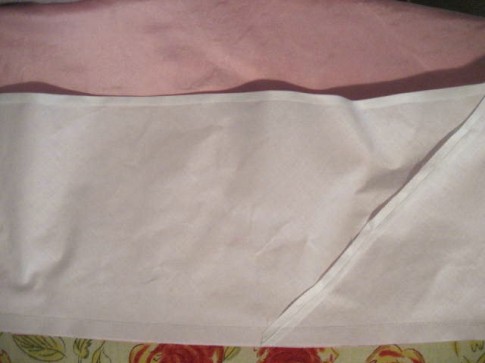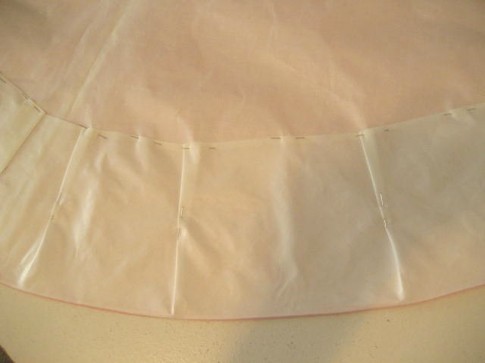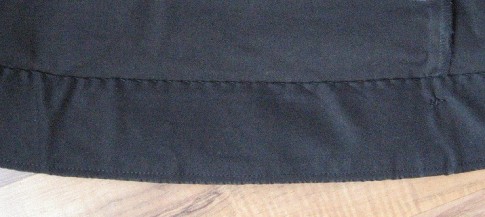
All the Victorians did it. They knew what to do to keep clothes lasting longer. They finagled fabric and thread until it gave them the silhouette they wanted.
One of the best things they utilized was the method of using a second or third layer of fabric to stiffen a particular area of a garment. (You may have heard of this as flatlining or mounting.) This reinforcement gave body to the fashion fabric, supported the silhouette desired, and miraculously cut down on the wear & tear of the garment.
Most obvious of this reinforcement layer is this use of supportive fabric in skirt hems known as hem facings.

Rarely did the mid-to-late 19th C. woman hem her skirt with just turning it up once and stitching down. No, they were as attentive to the bottom of their garments as anything else. Really if you think about it, the skirt hem gets nearly the same amount of wear (if not more) as the wrist cuff. Those folded up edges take a beating.
Generally, in modern sewing terms, facings finish raw edges and help support them as well. The facing is sewn on to the garment then turned to the inside and either left loose or tacked down. Cut on the same grain as the garment or a true bias, facings follow the edges to be finished like armholes in sleeveless tops and necklines.
In historical sewing, facings are kind of a mix of flatlining (a full lining layer) and simple edge finishes like bias strips. They can be flatlined to the inside of a garment which the raw edges are then finished together. Or facings can be shortened linings actually finishing a raw edge like in modern garments.
In terms of skirt hem facings specifically, there are two methods I’ve found to be the best when finishing the hems in skirts.
- Wide sections of fabric are laid flat on the inside of the skirt with the lower raw edges matching. The raw edges are then finished together.
- The facing and skirt are placed right sides together, seamed and the facing turned to the inside of the skirt.
Both these methods serve the purpose of supporting the skirt hem and are used according to the type of skirt and time period you are working with.
Types & Widths Of Hem Facings
Hem facings are a traditional way to finish the lower edges of skirts. They can be cut in straight strips across the fabric or on the bias for use in shaped or curved hems.
If your skirt is cut in straight panels such as those in the 1830s to 1850s, straight strips of fabric are fine to use as a hem facing. Straight hem facings can be from 1” up to 12” or more. In 1830s skirts, the hem facing could go as high as knee level.
For curved hems, as most skirts are, strips cut on the bias are best and can be anywhere from 1” to 6” or more in width.
Fabrics To Use
Hem facings can be cut from the fashion fabric or from a lining or underlining fabric. Being a support to the skirt fashion fabric, the facing fabric will depend on the time period you are creating. The style of the skirt and the weight needed at the hemline are also considered in choosing your facing fabric.
Try a heavy, tightly-woven cotton muslin for lighter-weight dress fabrics. Polished cotton (chintz) was VERY popular for underlinings and facings in the 19th Century and can be used from light cottons to heavy wools and silks.
Silk organza, although a fabulous bodice and collar underlining is not recommended for skirt facings because of the wear a skirt gets. Use a light muslin or calico instead.
Cotton organdy, the costumer’s dream fabric, is perfect hem facing material. Make sure to use the appropriate stiffness according to your fashion fabric. The stiffest stuff is great for 1890s hems which really need that hem support as it kicks out over the petticoats.
To strengthen a curved hem, modern horsehair braid can be enclosed between the bias hem facing and skirt. It is especially effective in kicking out the hem from the petticoats.
The modern horsehair braid available is a nylon mesh woven on a bias grain. It is usually sold in clear or black and comes in ½” to 3” widths. Wider goods are sold but it can get real expensive real fast.
As an option to horsehair, you can use hair canvas (found in the interfacing section of a fabric store) or a heavy fabric cut into bias strips and used as an inner layer between your hem facing and skirt. This would add weight and form to the skirt. Hair canvas is best for wool skirts.
Reproduction Costume Samples
Here are some examples of hem facings in use in reproduction costumes.

Above is a 1860s straight panel skirt with a straight hem facing of 3”. To further protect the lower edge of the skirt, a plain cotton bias tape was wrapped over the folded hem and top stitched on. This bias tape can be easily replaced and keeps the skirt in good condition.

Above is a 12” wide straight hem facing applied to a straight panel 1830s skirt. The facing is in the fashion fabric. After the facing was stitched to the skirt right sides together, the seam was rolled ¼” to the inside so the seam was not seen from the correct side. This is a period method that leaves the bottom of the skirt as a fold rather than a seam.

Above is a sharply curved 1870s skirt train with a 6” bias hem facing. The skirt was flatlined in a polished cotton and the facing cut from the same material.
You can see the small darts taken up in the hem facing to match the curve of the train or skirt hem. These darts are historically correct as seen on some original garments. Most often this hem facing was covered with a balayeuse or street sweeper which is simply a pleated ruffle that kept the hem edge clean and could be easily removed and cleaned or replaced.

This is another bias hem facing applied to a 1870s natural form era curved skirt hem. A 2” wide strip of horsehair was sandwiched between the skirt and the hem facing before the facing was whipstitched to the skirt.
Do you finish your skirts with hem facings? Have you noticed the difference they make in the overall silhouette of your skirt? After a costume was completed, do you wish a longer or shorter hem facing was used?

With the horsehair, which way was it placed? Grain or cross-grain (easy bend along the hem or up the skirt)?
For woven horsehair (not today’s nylon bias woven which you can shape), use either on-grain or cross for straight hems; for curved hems I recommend cutting the horsehair to your shaped facing to keep it flat on the inside with no pleating/darts to shape it. But putting in tiny darts to shape it is just fine too.
Very informative. I wanted to find out what the “brush binding” was attached to my great grandmother’s skirt, circa 1911, as described by my mother who was born in 1906
Starting in the 1840s a twill tape (or similar) was stitched on the skirt hem, wrapping around the edge to protect the front and back hem. It wasn’t too wide, maybe 1/2″ to 1″ visible on the front side. The tape could be replaced as needed and saved the skirt fabric from wear. The tape could also be cut from wool or velveteen, strong fabrics to take the brunt of hem wear.
Thank you Jennifer!
I have rarely seen such an article, precise, clear and full of details…
from Belgium